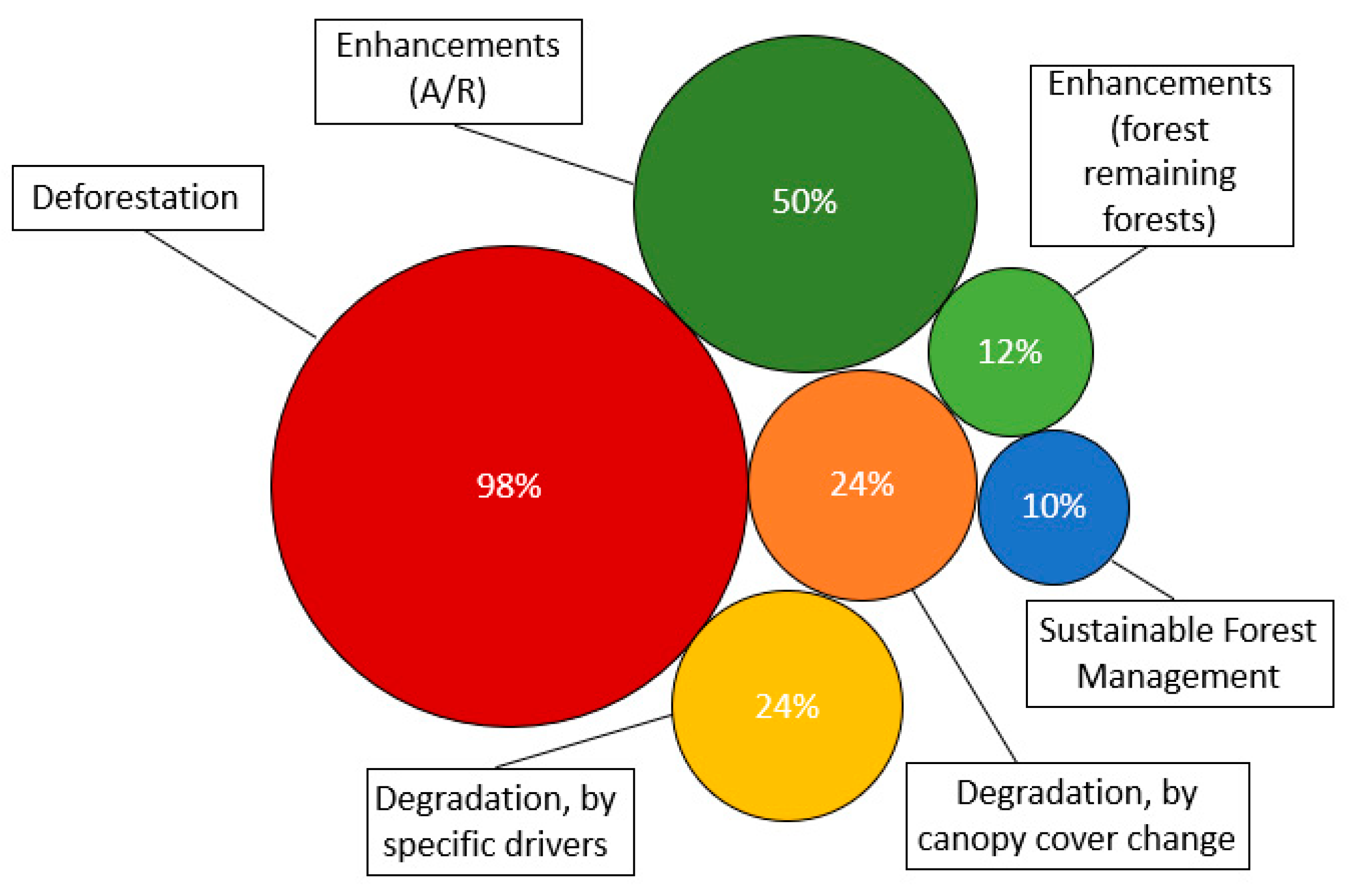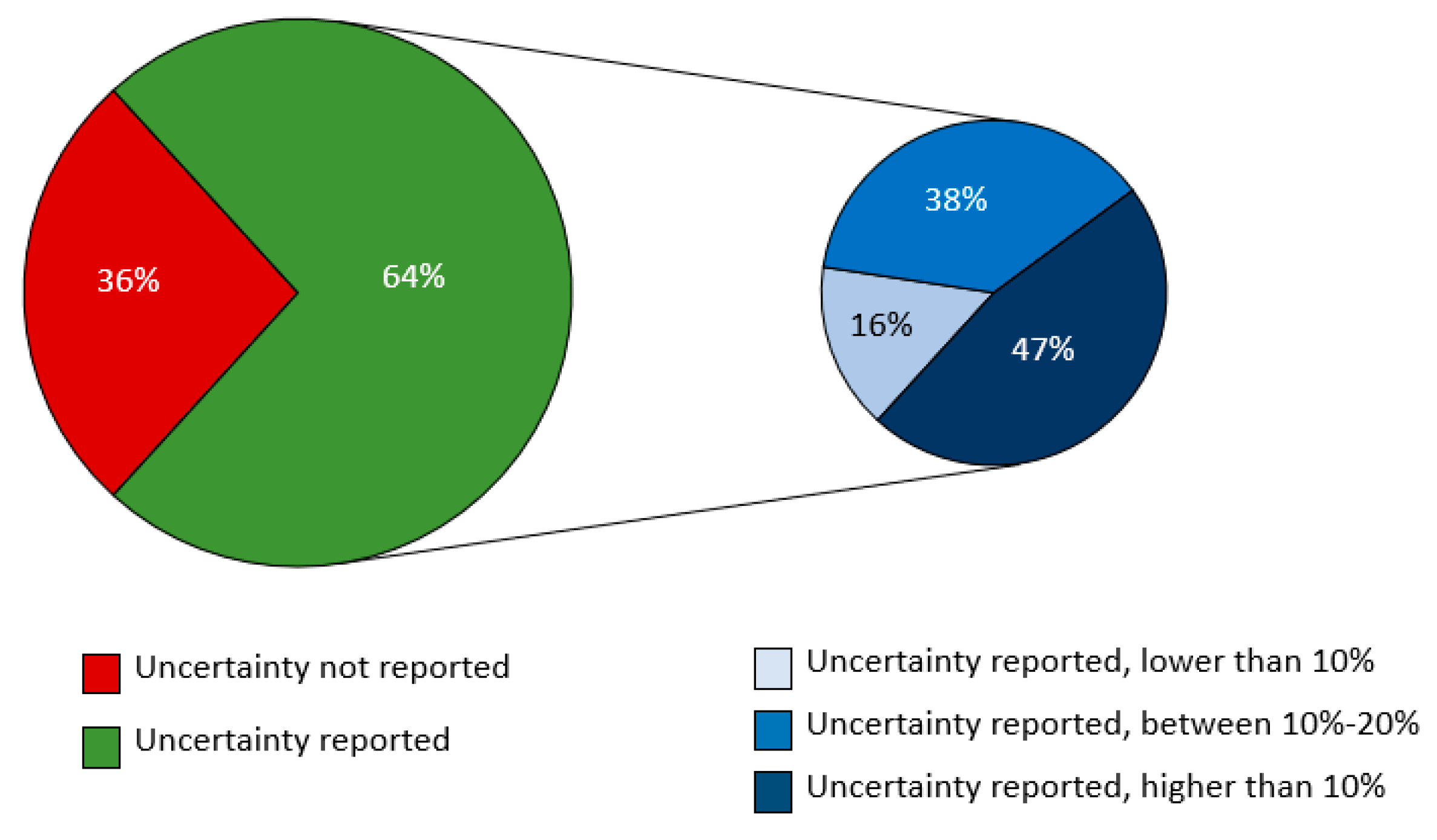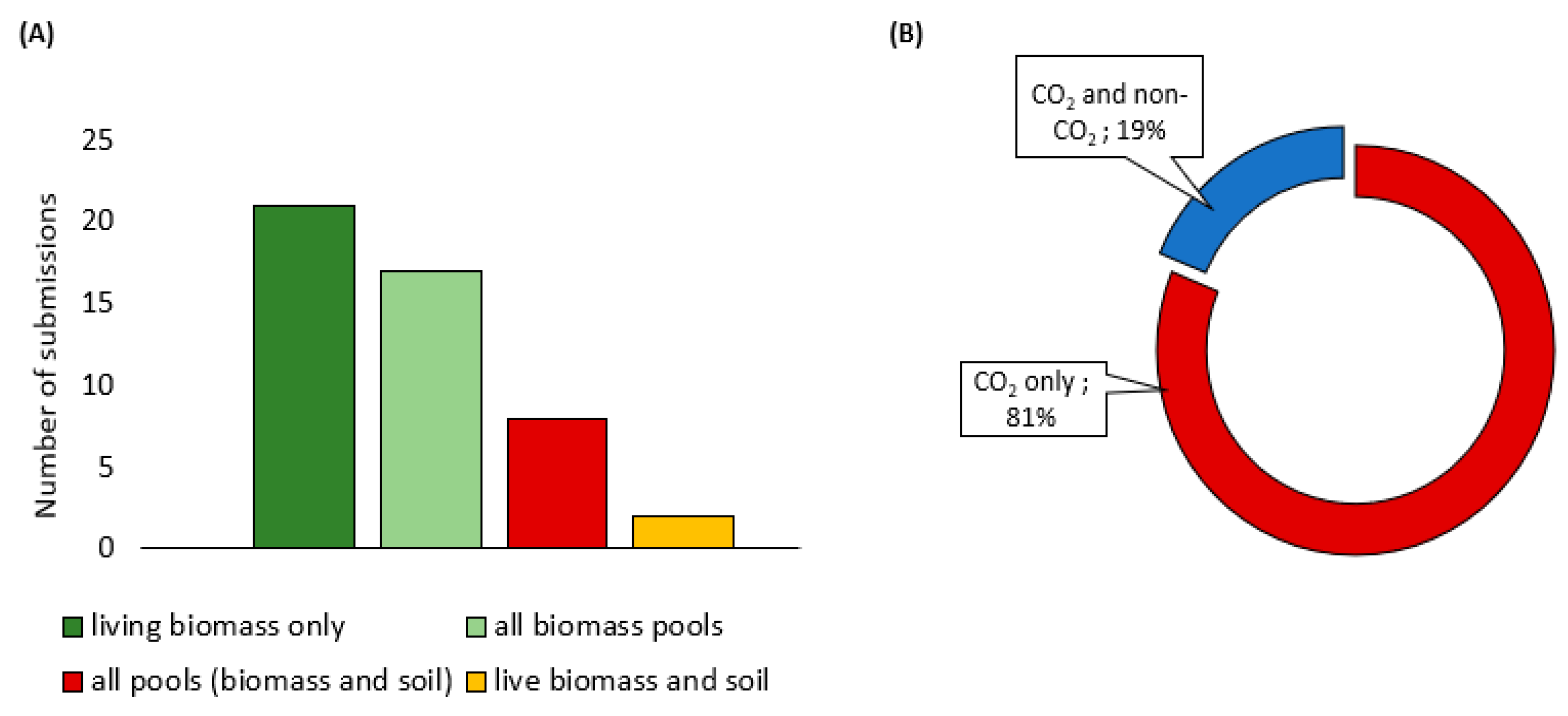Comprehensive Accounting for REDD+ Programs: A Pragmatic Approach as Exemplified in Guyana
Abstract
:1. Introduction
2. Forest Carbon Accounting
2.1. Basic Overview
2.2. Status of Global Efforts
3. REDD+ in Guyana
3.1. Overview
3.2. Deforestation and Forest Degradation GHG Emissions in Guyana
3.3. IPCC Key Category Analysis
4. Recommendations for Comprehensive and Cost-Effective REDD+ Programs
- Conduct a key category analysis (KCA) to assess significance of emission sources: While a KCA itself can be resource-intensive if all emissions are accounted with a relatively high level of certainty, there are alternative approaches that can be employed with initial approximate estimates of emission levels. Countries should develop order of magnitude estimates of emissions from all sources based on the best currently existing data, which in some cases may include global datasets and/or default values. From these estimates, it will be possible to establish which sources are likely to be significant and which are minor.
- Prioritize and pursue complete accounting for significant sources: For any source of emission, pool or gas that is expected to comprise more than 10% of total emissions, countries should apply a rigorous approach that allows full accounting with a low level of uncertainty.
- Engage in simplified accounting for insignificant sources: For the remaining sources of emissions, pools or gases, those comprising less than 10% of total emissions, countries should identify an appropriate cost-effective method to estimate emissions. This may entail use of Tier 1 defaults, application of appropriate literature values, or development of a simplified and cost-effective method to estimate emissions.
Supplementary Materials
Author Contributions
Funding
Acknowledgments
Conflicts of Interest
References
- Lee, D.; Sanz, M.J. UNFCCC Accounting for Forests: What’s in and What’s Out of NDCs and REDD+. 2017. Available online: http://www.climateandlandusealliance.org/wp-content/uploads/2017/09/Policy-brief-NDCs-and-REDD-revised-Sep-6-2017.pdf (accessed on 25 November 2020).
- Pearson, T.R.H.; Walker, S.; Brown, S. Sourcebook for Land Use, Land-Use Change and Forestry Projects; World Bank: Washington, DC, USA, 2005; Available online: https://openknowledge.worldbank.org/handle/10986/16491 (accessed on 25 November 2020).
- Pearson, T.R.H.; Brown, S.; Birdsey, R.A. Measurement Guidelines for the Sequestration of Forest Carbon; U.S. Department of Agriculture, Forest Service, Northern Research Station: Newtown Square, PA, USA, 2007. Available online: https://www.nrs.fs.fed.us/pubs/3292 (accessed on 25 November 2020).
- Global Observation of Forest Cover and Land Dynamics, (GOFC-GOLD). A Sourcebook of Methods and Procedures for Monitoring and Reporting Anthropogenic Greenhouse Gas Emissions and Removals Associated with Deforestation, Gains and Losses of Carbon Stocks in Forests Remaining Forests, and Forestation; COP 22 Version 1; Global Observation of Forest Cover and Land Dynamics (GOFC-GOLD): Wageningen University, The Netherlands, 2016; Available online: http://www.gofcgold.wur.nl/redd/sourcebook/GOFC-GOLD_Sourcebook.pdf (accessed on 25 November 2020).
- Neeff, T.; Lee, D. Lessons Learned for REDD+ from Evaluations of GHG Statements. Global Forest Observations Initiative, 2018. Available online: https://www.forestcarbonpartnership.org/system/files/documents/CF17%204i.%20Lessonsfrom%20REDD%2B%20evaluations_%20Jan%202018_final_0.pdf (accessed on 25 November 2020).
- Watson, C. Forest Carbon Accounting: Overview and Principles. Report for UNDP. 2009. Available online: http://www.undp.org/content/undp/en/home/librarypage/environment-energy/climate_change/mitigation/forest-carbon-accounting-overview---principles.html (accessed on 25 November 2020).
- Wertz-Kanounnikoff, S.; Verchot, L.V.; Kanninen, M.; Murdiyarso, D. How can we monitor, report and verify carbon emissions from forests. In Moving Ahead with REDD: Issues, Options and Implications; Center for International Forestry Research (CIFOR): Bogor, Indonesia, 2008; p. 172. Available online: https://www.cifor.org/publications/pdf_files/Books/BAngelsen0801.pdf (accessed on 25 November 2020).
- Intergovernmental Panel on Climate Change, (IPCC). Agriculture, Forestry and Other Land Use. In IPCC Guidelines for National Greenhouse Gas Inventories; National Greenhouse Gas Inventories Programme; Eggleston, H.S., Buendia, L., Miwa, K., Ngara, T., Tanabe, K., Eds.; 2006; Volume 4, Available online: http://www.ipcc-nggip.iges.or.jp/public/2006gl/vol4.html (accessed on 25 November 2020).
- Forest Carbon Partnership Facility, (FCPF). Carbon Fund Methodological Framework; Forest Carbon Partnership Facility, The World Bank: Washington, DC, USA, 2016; Available online: https://www.forestcarbonpartnership.org/carbon-fund-methodological-framework (accessed on 25 November 2020).
- Food and Agriculture Organization of the United Nations, (FAO). Emerging Approaches to Forest Reference Emission Levels and Forest Reference Levels for REDD+; Food and Agriculture Organization of the United Nations (FAO): Rome, Italy, 2015; Available online: http://www.fao.org/3/a-i4846e.pdf (accessed on 25 November 2020).
- United Nations Framework Convention on Climate Change, (UNFCCC). Report of the Conference of the Parties on Its Sixteenth Session, Held in Cancun from 29 November to 10 December 2010; United Nations Framework Convention on Climate Change (UNFCCC): Rio de Janeiro, Brazil; New York, NY, USA, 2011; Available online: https://unfccc.int/documents/6527 (accessed on 25 November 2020).
- McMurray, A.; Pearson, T.; Casarim, F. Guidance on Applying the Monte Carlo Approach to Uncertainty Analyses in Forestry and Greenhouse Gas Accounting. 2017. Available online: https://www.winrock.org/wp-content/uploads/2018/03/UncertaintyReport-12.26.17.pdf (accessed on 25 November 2020).
- Food and Agriculture Organization of the United Nations, (FAO). From Reference Levels to Results Reporting: REDD+ under the United Nations Framework Convention on Climate Change. 2019 Update; Food and Agriculture Organization of the United Nations (FAO): Rome, Italy, 2019; Available online: http://www.fao.org/3/ca6031en/ca6031en.pdf (accessed on 25 November 2020).
- Intergovernmental Panel on Climate Change, (IPCC). Climate Change 2014: Synthesis Report. Contribution of Working Groups I, II and III to the Fifth Assessment Report of the Intergovernmental Panel on Climate Change; Intergovernmental Panel on Climate Change (IPCC): Geneva, Switzerland, 2014; Available online: https://www.ipcc.ch/report/ar5/syr/ (accessed on 25 November 2020).
- Pearson, T.R.H.; Brown, S.; Murray, L.; Sidman, G. Greenhouse gas emissions from tropical forest degradation: An underestimated source. Carbon Balance Manag. 2017, 12, 1–11. [Google Scholar] [CrossRef] [PubMed] [Green Version]
- Pearson, T.R.H.; Brown, S.; Casarim, F.M. Carbon emissions from tropical forest degradation caused by logging. Environ. Res. Lett. 2014, 9, 1–11. [Google Scholar] [CrossRef] [Green Version]
- Contreras-Hermosilla, A.; Doornbosch, R.; Lodge, M. The Economics of Illegal Logging and Associated Trade 2007. Available online: https://www.oecd.org/sd-roundtable/papersandpublications/39348796.pdf (accessed on 25 November 2020).
- Lawson, S.; MacFaul, L. Illegal Logging and Related Trade, Indicators of the Global Response; Chatham House: London, UK, 2010. [Google Scholar]
- Food and Agriculture Organization of the United Nations, (FAO). Global Forest Resources Assessment 2020: Main Report; Food and Agriculture Organization of the United Nations (FAO): Rome, Italy, 2020; Available online: https://doi.org/10.4060/ca9825en (accessed on 25 November 2020).
- Guyana Forestry Commission Guyana REDD+ Monitoring Reporting & Verification System (MRVS) Year 8 Interim Measures Report. 2019. Available online: https://forestry.gov.gy/wp-content/uploads/2019/11/Guyana-MRVS-Year-8-Report-Version-1.pdf (accessed on 25 November 2020).
- Government of the Cooperative Republic of Guyana. The Reference Level for Guyana’s REDD+ Program.; UNFCCC REDD+ Web Platform: Guyana, 2015; Available online: https://redd.unfccc.int/files/guyana_proposal_for_reference_level_for_redd_.pdf (accessed on 25 November 2020).
- Intergovernmental Panel on Climate Change, (IPCC). Good Practice Guidance and Uncertainty Management in National Greenhouse Gas Inventories; 2001. Available online: https://www.ipcc-nggip.iges.or.jp/public/gp/english/ (accessed on 25 November 2020).
- Brown, S.; Mahmood, A.R.J.; Goslee, K.M.; Pearson, T.R.H.; Sukhdeo, H.; Donoghue, D.N.M.; Watt, P. Accounting for greenhouse gas emissions from diffuse forest degradation: Gold mining in Guyana as a case study. Forests under review.
- Brown, S.; Mahmood, A.R.J.; Goslee, K. Forest Degradation around Mined Areas: Methods and Data Analyses for Estimating Emission Factors. Report to Guyana Forestry Commission. 2015. Available online: https://forestry.gov.gy/wp-content/uploads/2016/11/Assessing-Mining-Degradation-Impacts-in-Guyana-2016.pdf (accessed on 25 November 2020).
- Chave, J.; Andalo, C.; Brown, S.; Cairns, M.A.; Chambers, J.Q.; Eamus, D.; Folster, H.; Fromard, F.; Higuchi, N.; Kira, T.; et al. Tree allometry and improved estimation of carbon stocks and balance in tropical forests. Oecologia 2005, 145, 87–99. [Google Scholar] [CrossRef] [PubMed]
- Mokany, K.; Raison, R.J.; Prokushkin, A.S. Critical analysis of root: Shoot ratios in terrestrial biomes. Global Change Biology 2006, 12, 84–96. [Google Scholar] [CrossRef]
- Harmon, M.E.; Sexton, J. Guidelines for Measurements of Woody Detritus in Forest Ecosystems; LTER Network Office, University of Washington: Seattle, WA, USA, 1996; Available online: https://andrewsforest.oregonstate.edu/publications/2255 (accessed on 25 November 2020).
- Nelson, D.W.; Sommers, L.E. Total Carbon, Organic Carbon, and Organic Matter. In Methods of Soil Analysis: Part 3 Chemical Methods; SSSA Book Series; Soil Science Society of America: Madison, WI, USA, 1996; pp. 961–1010. [Google Scholar] [CrossRef]
- Donoghue, D.; Galiatsatos, N. Accuracy Assessment Report Year 7 Guyana REDD+ MRVS. Accuracy Assessment Report. Submitted to Guyana Forestry Commission. 2018. Available online: https://forestry.gov.gy/wp-content/uploads/2018/11/Accuracy-Assessment-Guyana-MRVS-Year-7.pdf (accessed on 25 November 2020).
- Schroeder, W.; Oliva, P.; Giglio, L.; Csiszar, I.A. The New VIIRS 375m active fire detection data product: Algorithm description and initial assessment. Remote Sens. Environ. 2014, 143, 85–96. [Google Scholar] [CrossRef]
- Bernal, B.; Murray, L.T.; Pearson, T.R. Global carbon dioxide removal rates from forest landscape restoration activities. Carbon Balance Manag. 2018, 13. [Google Scholar] [CrossRef] [PubMed]



| Activity | Emissions Estimate (×1000 t CO2e) | Percent (%) of Total Emissions |
|---|---|---|
| Deforestation total | 9514 | 83.4% |
| Mining | 7249 | 63.5% |
| Mining infrastructure | 719 | 6.3% |
| Agriculture | 565 | 5.0% |
| Fire/biomass burning | 532 | 4.7% |
| Forestry infrastructure | 372 | 3.3% |
| Infrastructure (primary roads) | 70 | 0.6% |
| Settlements | 7 | 0.1% |
| Forest degradation total | 1900 | 16.6% |
| Timber harvest | 1831 | 16.0% |
| Mining degradation | 56 | 0.5% |
| Illegal logging | 11 | 0.1% |
| Infrastructure degradation 1 | 2 | 0.02% |
| Total emissions | 11,414 | 100.0% |
| Pool | Approach | Source |
|---|---|---|
| Aboveground biomass | Calculated as a function of wood density and diameter at breast height, using equation for moist tropical forests | [25] |
| Belowground biomass | Ratio of aboveground biomass | [26] |
| Saplings | One-time destructive sampling to develop an average dry weight per sapling and count of saplings at each plot | [2] |
| Standing dead wood | Calculated as a function of volume and density of dead wood by class | [2] |
| Lying dead wood | Line-intersect method, using density of dead wood by class | [27] |
| Litter | Litter “clip plots”, with samples oven-dried | [2] |
| Soil carbon | Soil carbon sampling with corer and bulk density measurements from soil pit | [28] |
| Potential Pragmatic Approach | Detailed Approach | ||
|---|---|---|---|
| Inclusion of diffuse degradation sources† | EF | Limited fieldwork and analysis | Fieldwork and analysis |
| AD | Buffers applied around new areas of deforestation (minimal additional analysis) | Annual high-resolution imagery with processing and analysis | |
| Inclusion of emissions from fire | EF | IPCC defaults | In-country fieldwork to determine fire emission factors |
| AD | Use of global fire databases (e.g., [30]) | Country-specific remote sensing analysis | |
| Inclusion of enhancement activities | Focus on non-forest to forest | Non-forest to forest AND Enhancement in forest remaining forest | |
| EF | IPCC and literature (e.g. [31]) for removal factors. | Extensive scientific studies to establish country-specific removal factors | |
| AD | National statistics on forest plantations and restoration, or remote sensing | Remote sensing (high resolution analyses needed for enhancements in forest remaining forest) | |
| Comprehensive inclusion of carbon pools | Use of IPCC defaults for dead organic matter and soil organic matter pools | Extensive fieldwork and laboratory analyses | |
| Comprehensive inclusion of gases | Use of IPCC defaults for CH4 and N2O | Extensive scientific studies to establish country-specific factors | |
| Uncertainty | Low uncertainty for activities, pools and gases that contribute significantly to total emissions and higher uncertainty for remaining activities, pools and gases | Low uncertainty for all activities, pools and gases |
Publisher’s Note: MDPI stays neutral with regard to jurisdictional claims in published maps and institutional affiliations. |
© 2020 by the authors. Licensee MDPI, Basel, Switzerland. This article is an open access article distributed under the terms and conditions of the Creative Commons Attribution (CC BY) license (http://creativecommons.org/licenses/by/4.0/).
Share and Cite
Goslee, K.M.; Pearson, T.R.H.; Bernal, B.; Simon, S.L.; Sukhdeo, H. Comprehensive Accounting for REDD+ Programs: A Pragmatic Approach as Exemplified in Guyana. Forests 2020, 11, 1265. https://doi.org/10.3390/f11121265
Goslee KM, Pearson TRH, Bernal B, Simon SL, Sukhdeo H. Comprehensive Accounting for REDD+ Programs: A Pragmatic Approach as Exemplified in Guyana. Forests. 2020; 11(12):1265. https://doi.org/10.3390/f11121265
Chicago/Turabian StyleGoslee, Katherine M., Timothy R. H. Pearson, Blanca Bernal, Sophia L. Simon, and Hansrajie Sukhdeo. 2020. "Comprehensive Accounting for REDD+ Programs: A Pragmatic Approach as Exemplified in Guyana" Forests 11, no. 12: 1265. https://doi.org/10.3390/f11121265
APA StyleGoslee, K. M., Pearson, T. R. H., Bernal, B., Simon, S. L., & Sukhdeo, H. (2020). Comprehensive Accounting for REDD+ Programs: A Pragmatic Approach as Exemplified in Guyana. Forests, 11(12), 1265. https://doi.org/10.3390/f11121265






